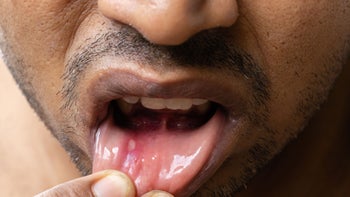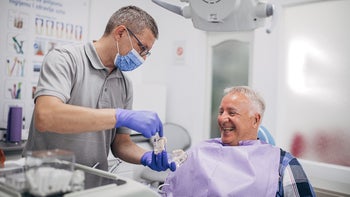
How Much Does a Dental Crown Cost? Average Prices With and Without Insurance
Key takeaways:
Dental crowns are tooth-shaped caps placed over damaged teeth to restore strength and appearance.
The price of a dental crown averages between $800 and $2,500 without insurance. The cost depends on the material used.
You can save on a dental crown by comparing dental insurance plans, checking out dental savings plans, and visiting a dental school.
Table of contents

Losing teeth because of poor oral health affects your ability to eat, but it can also change the shape of your jaw, affect your sinuses, and even increase your risk of certain medical conditions. Fortunately, if you have a badly damaged or decayed tooth, you can often save it by getting a dental crown.
Dental crowns are made of ceramic, metal, or a combination of these materials that are designed to look and act like a tooth. It can also be used to replace a missing tooth, either as part of a dental bridge or as a component of a dental implant.
The cost of a dental crown can be several hundred dollars. It depends on several factors, such as the amount of work involved and the material used. Fortunately, there are ways to save money, including shopping for dental savings plans and receiving services from a dental school.
Search and compare options
How much does a dental crown cost?
Without insurance, the average cost of a single dental crown ranges from $800 to $2,500. The price depends largely on the material.
Most dental crowns consist of the following substances:
All ceramic or zirconia: Dental crowns made of all ceramic or zirconia are the most natural-looking option and tend to be the most durable. All-porcelain crowns are typically used for front teeth, while zirconia crowns can be used for front and back teeth. According to Authority Dental, all-ceramic or zirconia crowns cost $1,000 to $2,500, with an average cost of $1,300.
Metal: Metal crowns usually go on molars. The cost depends in part on the alloy used. For example, gold alloy crowns cost more than those made from base metal alloys, such as nickel-chromium, cobalt-chromium, or nickel-titanium. Authority Dental lists the cost of a metal crown at $900 to $2,500, with an average price of about $1,300.
Porcelain and metal: Another strong and natural-looking option is a crown made of porcelain and metal. These dental crowns can be placed anywhere in the mouth. Authority Dental reports a porcelain fused to metal crown costs $800 to $2,400, with an average cost of $1,100.
Other costs associated with a dental crown
You might need other dental procedures in preparing for the placement of your crown. This table lists possible services and prices:
Service | Cost range |
Dental exam | $50-$200 |
X-ray | $25-$50 |
$150-$750 | |
$50-$300 | |
$200-$500 | |
$250-$650 | |
Protective restoration, such as a temporary filling | $90-$250 |
$700-$2,100 |
Does insurance cover dental crowns?
Private dental insurance typically covers medically necessary crowns and usually pays about 50% of the cost. About 61% of adults have private dental insurance. Many plans have an annual coverage cap of $1,000 to $2,500, so be sure to check your policy.
Most policies have waiting periods ranging from a few months to over a year before providing major dental benefits. You might also consider a dental discount plan. Some of these plans may include price breaks on cosmetic procedures as well.
Original Medicare covers dental treatment only if it takes place while you are in the hospital. Many Medicare Advantage plans provide more comprehensive dental coverage. Additional premiums and cost sharing are often required. Exact prices and percentages may depend on whether your dental treatments are done in network or out of network.
Crowns vs. fillings: Learn the difference in cost and the distinct purposes of crowns and fillings.
Save money on dental care: Discover seven tips to cut the costs of your oral health needs.
Dental savings plans: Find out how dental discount plans can make oral care more affordable.
Medicaid offers dental coverage for children, including medically necessary crowns. But for adults, dental coverage depends on where you live. For example, New York Medicaid covers a range of adult dental services, including preventive care, while Nevada Medicaid offers limited dental coverage for adults 21 or older and expanded dental coverage for pregnant members 21 or older.
What’s required when you get a dental crown?
Getting a dental crown typically involves two visits to the dentist.
During your first visit, the dentist or prosthodontist will make an impression of the existing tooth and then remove a small layer of the tooth structure to make room for the crown. They may also perform a root canal treatment or fill a cavity in preparation for the dental crown. The dentist will protect the tooth with a temporary crown until the permanent one is ready, which usually takes 2 to 3 weeks. At that time, you’ll go back to the dentist to have the permanent crown placed.
Is getting a dental crown worth it?
Whether a dental crown is worth the cost depends on the reason you’re getting the crown and how much you’re spending. The amount you spend depends on whether you have dental insurance and whether the procedure is medically necessary.
Medically necessary reasons to get a dental crown may include:
Repairing a cracked or severely damaged tooth
Reinforcing the structure of a tooth after a root canal
Filling and stabilizing a tooth with a large cavity
Replacing a missing tooth using an implant or a bridge
For some wide or deep cavities, you may have the choice between a large filling or a dental crown. A dental crown is more expensive, but it also gives the tooth more protection and reinforcement. If you go without the dental crown, you may eventually need to have the tooth extracted.
Sometimes people want dental crowns to improve the appearance of their stained, chipped, worn, or uneven teeth. But most insurers consider these dental crowns cosmetic and will not cover them. You might want to consider other options, such as veneers or a whitening treatment, to see if they are less expensive.
Pros of getting a dental crown
Shields your tooth from further damage
Often enables you to keep your tooth
Protects your tooth for several years
Cons of getting a dental crown
Eventually needs repair or replacement
If not medically necessary, the procedure will be an out-of-pocket expense
Preparation of the tooth may leave it extra sensitive
What to ask your dentist to get the right type of crown
During your consultation for a dental crown, you’ll want to ask your dentist questions, such as:
Which dental crown material is best given the location of the tooth and my budget?
How long do dental crowns made from that material typically last?
What type of care will keep my dental crown in good shape for as long as possible?
Will metal alloys in the dental crown cause an allergic reaction?
Is a same-day crown appropriate?
Are you able to fabricate the dental crown in your office?
Ways to save on dental crowns
There are many ways to save money on dental crowns:
Shop dental insurance plans. Evaluate different dental insurance plans to discover the one that best aligns with your budget and needs.
Buy a dental savings plan. A dental savings (or discount) plan operates through a network of dentists who agree to accept negotiated, discounted rates for dental services and treatments, reducing your out-of-pocket expenses.
Go to a dental school. Dental schools often have clinic hours. Call to ask about treatments and procedures offered at reduced rates.
Ask about payment plans. If you receive a higher bill than expected from your dentist, explain your financial situation, and ask about a payment plan.
Schedule an appointment at a community health center. Community-based clinics are typically in underserved areas and may provide routine and specialty dental services on a sliding fee scale.
Use an HSA or FSA. You can use tax-advantaged accounts, such as a health savings account (HSA) or flexible spending accounts (FSA), to cover a variety of eligible dental expenses, including crowns.
Maintain your oral health. Get your teeth cleaned and a routine dental exam twice a year. Floss daily, and brush your teeth twice a day.
The bottom line
The price of a dental crown depends primarily on the material used to make it, which may be ceramic, zirconia, metal, or a metal-porcelain combination. Dental crown prices range from $800 to $2,500.
Dental insurance often covers half of the cost if you’re getting a crown that’s medically necessary. Dental insurance likely won’t cover the cost of a crown if you’re getting it for cosmetic reasons. There are many ways to save money, including comparing dental plans and visiting a dental school.
Why trust our experts?



References
Academy of Prosthodontics. (2017). The glossary of prosthodontic terms. The Journal of Prosthetic Dentistry.
Advanced Smile Dentistry. (2024). Types of dental crowns and cost of each type dental crowns.
Alqahtani, S., et al. (2020). Maxillary sinus pneumatization following extractions in Riyadh, Saudi Arabia: A cross-sectional study. Cureus.
Anthem. (n.d.). Dental insurance waiting periods.
Baroudi, K., et al. (2015). Assessment of chair-side computer-aided design and computer-aided manufacturing restorations: A review of the literature. Journal of International Oral Health.
Clarius, A. (2024). What to know before getting a dental crown. NewMouth.
Consumer Guide to Dentistry. (n.d.). Dental crowns: Preserving damaged teeth.
Foundation for Oral Rehabilitation. (n.d.). Diagnostic casts and wax-up.
Freed, M., et al. (2021). Medicare and dental coverage: A closer look. KFF.
Hadianfar, S., et al. (2024). How much does a dental crown cost in 2024? Authority Dental.
Harchandani, N., et al. (2024). How much does a root canal treatment cost in 2024? Authority Dental.
Health Policy Institute. (2024). National trends in dental care use, dental insurance coverage, and cost barriers. American Dental Association.
Kotronia, E., et al. (2021). Oral health and all-cause, cardiovascular disease, and respiratory mortality in older people in the UK and USA. Scientific Reports.
Liberty Dental Plan of Nevada. (n.d.). Dental care services information sheet.
Medicare.gov. (n.d.). Dental services. Centers for Medicare & Medicaid Services.
New York State Department of Health. (2024). Medicaid dental benefits.
Roach, M. (2007). Base metal alloys used for dental restorations and implants. Dental Clinics of North America.
Syed, M., et al. (2015). Allergic reactions to dental materials - a systematic review. Journal of Clinical and Diagnostic Research.
Taylor, T. D., et al. (2018). Position statement: What is a prosthodontist and the dental specialty of prosthodontics? American College of Prosthodontists.
U.S. Food & Drug Administration. (2020). Dental cone-beam computed tomography.

























